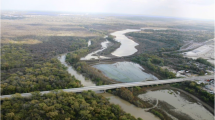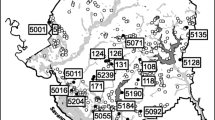Abstract
The objective of this study was to characterize the zooplankton and phytoplankton assemblages of four different types of wetlands and to evaluate their use as environmental indicators. Total abundances, community composition, and species diversity were evaluated for zooplankton and phytoplankton assemblages from 24 wetlands and related to water quality variables. During August 1995, six representative sites were sampled from four types of wetlands designated as constructed, impacted, non-impacted, or temporary. The plankton assemblages of all wetlands were dominated by cosmopolitan crustacean, rotifer, and phytoplankton taxa typical of lake plankton communities. Species diversity, richness, and evenness of zooplankton and phytoplankton assemblages did not differ significantly among the wetland types. Total zooplankton abundance was significantly (p < 0.01) related to chlorophyll a and total phosphorus concentrations over the range of trophic conditions. Mean zooplankton densities and phytoplankton biovolumes were similar among the wetlands, however, the relative abundances of major zooplankton groups differed among the wetland types. Cyanophytes, primarily Oscillatoria spp., were a major component of the phytoplankton across all four wetland types, and were significantly more abundant within the constructed and temporary sites. On average, rotifers accounted for 79% of total zooplankton abundance within the constructed wetlands and were much less dominant in the non-impacted and temporary wetlands. Cladoceran, copepodite, and adult copepod concentrations were low in the constructed and impacted wetlands and increased in the non-impacted and temporary wetlands in conjunction with increased chlorophytes and cryptophytes. Our preliminary survey suggests that abiotic factors which are known to directly affect phytoplankton may indirectly affect zooplankton composition in such a way as to use zooplankton assemblages as indicators of water quality. However, further study incorporating seasonal dynamics and the influence of predators on zooplankton assemblages is needed to fully assess the use of zooplankton community composition as an environmental indicator for wetland systems.
Similar content being viewed by others
References
Acton, J. K., 1996. Midsummer Plankton Communities of Select Ohio Wetlands. M.S. Thesis, University of Akron, Akron, OH.
American Public Health Association, 1985. Standard Methods for the Examination of Water and Wastewater, 16th edn. Washington, DC. 1268 pp.
Andreas, B. K. & J. D. Knoop, 1992. 100 years of changes in Ohio's peatlands. Ohio J. Sci. 5: 130–138.
Brooks, J. L. & S. I. Dodson, 1965. Predation, body size, and composition of plankton. Science 150: 28–35.
Brower, J. E., J. H. Zan, & L. N. von Ende, 1990. Species diversity. In Methods for General Ecology, 3rd edn. William C. Brown Publishers, Dubuque, IA: 153–175.
Carmichael, W. W., 1996. Toxic Microcystis and the environment. In Toxic Microcystis. CRC Press, Boca Raton, FL, 262 pp.
Carter, J. C. H., 1969. Life cycles of Limnocalanus macrurus and Senecella calanoides, and seasonal abundance and vertical distribution of various planktonic copepods in Parry Sound, Georgian Bay. J. Fish. Res. Bd Can. 26: 2543–2560.
Castenholz, R. W., 1969. Thermophilic blue-green algae and the thermal environment. Bact. Rev. 33: 476–504.
Chen, C. Y. & C. L. Folt, 1993. Measures of food quality as demographic predictors in freshwater copepods. J. Plankton Res. 15: 1247–1261.
Cowardin, L. M., V. Carter, F. C. Golet, & E. T. LaRoe, 1979. Classification of wetlands and deepwater habitats of the United States. U.S. Fish and Wildlife Service Pub. FWS/OBS-79/31, Washington, DC, 103 pp.
Edmondson, W. T., 1959. Freshwater Biology. John Wiley and Sons, Inc., New York, 1248 pp.
Edmondson, W. T., & A. H. Litt, 1982. Daphnia in Lake Washington. Limnol. Oceanogr. 27: 272–293.
Fryer, G., 1957. The food of some freshwater cyclopoid copepods and its ecological significance. J. Anim. Ecol. 26: 263–286.
Fryer, G., 1968. Evolution and adaptive radiation in the Chydoridae (Crustacea:Cladocera): a study in comparative functional morphology and ecology. Phil. Trans. R. Soc., Lond., B 254: 221–385.
Fulton, R. S., 1988. Grazing on filamentous algae by herbivorous zooplankton. Freshwat. Biol. 20: 263–271.
Gannon, J. E. & R. S. Stemberger, 1978. Zooplankton (especially crustaceans and rotifers) as indicators of water quality. Trans. Am. Micros. Soc. 97: 16–35.
Gilbert, J. J., 1990. Differential effects of Anabaena affinis on cladocerans and rotifers: mechanisms and implications. Ecology 71: 1727–1740.
Gliwicz, Z. M., 1977. Food size selection and seasonal succession of filter feeding zooplankton in an eutrophic lake. Ekol. Pol. 25: 179–225.
Gophen, M., 1978. Zooplankton. In J. Illies (ed.) Monographiae Biologicae 32. C. Serruya (ed.) Lake Kinneret. Dr W. Junk Publishers, The Hague: 297–311.
Hall, D. J., S. T. Threlkeld, C. W. Burns, & P. H. Crowley, 1976. The size-efficiency hypothesis and the size structure of zooplankton communities. Ann. Rev. Ecol. Syst. 7: 177–208.
Hann, B. J. & L. Zrum, 1997. Littoral microcrustaceans (Cladocera, Copepoda) in a prairie coastal wetland: seasonal abundance and community structure. Hydrobiologia 357: 37–52.
Hannazato, T., 1996. Toxic cyanobacteria and the environment. In Toxic Microcystis. CRC Press, Boca Raton, FL, 236 pp.
Hansen, A. & E. Jeppesen, 1992. Life cycle of Cyclops vicinus in relation to food availability, predation, diapause and temperature. J. Plankton Res. 14: 591–605.
Infante, A. & W. Riehl, 1984. The effect of Cyanophyta upon zooplankton in aeutrophic tropical lake (Lake Valencia, Venezuela). Hydrobiologia 113: 293–298.
Kerfoot, W. C. & K. L. Kirk, 1991. Degree of taste discrimination among suspension-feeding cladocerans and copepods: Implications for detritivory and herbivory. Limnol. Oceanogr. 36: 1107–1123.
Kirk, K. L. & J. J. Gilbert, 1990. Suspended clay and the population dynamics ofplanktonic rotifers and cladocerans. Ecology 71: 1741–1755.
Knisely, K. & W. Geller, 1986. Selective feeding of four zooplankton species on natural lake phytoplankton. Oecologia 69: 86–94.
Krieger, K. A., 1992. The ecology of invertebrates in Great Lakes coastal wetlands: Current knowledge and research needs. J. Great Lakes Res. 18: 634–650.
Lair, N., 1991. Grazing and assimilation rates of natural populations of planktonic cladocerans in a eutrophic lake. Hydrobiologia 215: 51–61.
MacIsaac, H. J. & J. J. Gilbert, 1989. Competition between rotifers and cladocerans of different body sizes. Oecologia 81: 295–301.
MacIsaac, H. J. & J. J. Gilbert, 1991. Competition between Keratella cochlearis and Daphnia ambigua: effects of temporal patterns of food supply. Freshwat. Biol. 25: 189–198.
Magadza, C. H. D., 1994. Evaluation of eutrophication control in Lake Chivero, Zimbabwe, by multivariate analysis of zooplankton. Hydrobiologia 272: 277–292.
Maier, G., 1989. Variable life cycles in the freshwater copepod Cyclops vicinus (Uljanin1875): Support for the predator avoidance hypothesis? Arch. Hydrobiol. 115: 203–219.
Maier, G., 1996. Copepod communities in lakes of varying trophic degree. Arch. Hydrobiol. 136: 455–465.
Mason, C. E. & M. M. Abdul-Hussein, 1991. Population dynamics and production of Daphnia hyalina and Bosmina longirostris in a shallow, eutrophic reservoir. Freshwat. Biol. 25: 243–260.
McCormac, J. S. & G. J. Schneider, 1994. Floristic diversity of a disturbed western Ohio fen. Rhodora 96: 327–353.
Murtaugh, P. A., 1989. Size and species composition of zooplankton in experimental ponds with and without fishes. J. Freshwat. Ecol. 5: 27–38.
Niswander, S. F. & W. J. Mitsch, 1995. Functional analysis of a two-year old created in-stream wetland: hydrology, phosphorus retention, and vegetation survival growth. Wetlands 15: 212–225.
Pace, M. L., 1986. An empirical analysis of zooplankton community size structure across lake trophic gradients. Limnol. Oceanogr. 31: 45–55.
Papinska, K., 1988. The effect of fish predation on Cyclops life cycle. Hydrobiologia 167/168: 449–453.
Patrick, R. & C. W. Reimer, 1975a. The Diatoms of the U.S., vol. 1. The Academy of Natural Science of Philadelphia, Philadelphia, PA, 688 pp.
Patrick, R. & C. W. Reimer, 1975b. The Diatoms of the U.S., vol. 2, part 1. The Academy of Natural Science of Philadelphia, Philadelphia, PA, 213 pp.
Pennak, R. W., 1991. Fresh-water Invertebrates of the United States, 3rd edn. John Wiley and Sons, Inc., New York, 628 pp.
Prescott, G. W., 1962, Algae of the Western Great Lakes Area. William C. Brown Publishers, Dubuque, IA. 977 pp.
Reutter, V. M. & J. M. Reutter, 1975. Zooplankton of western Lake Erie of Put-in-Bay:a quantitative study, April 1973–March 1974. Ohio J. Sci. 75: 256–262.
Ruttner-Kolisko, A., 1974. Plankton Rotifers, Biology and Taxonomy. E. Schweizerbart'sche Verlagsbuchhandlung (Nagele U. Obermiller). Gerbruder Ranz, Dietenheim, 146 pp.
Santer, B., 1993. Potential importance of algae in the diet of adult Cyclops vicinus. Freshwat. Biol. 30: 269–278.
Soto, D. & S. H. Hurlbert, 1991. Short term experiments on calanoid-cyclopoid-phytoplankton interactions. Hydrobiologia 215: 83–110.
Smith, G. M., 1950. Fresh-water Algae of the United States, 2nd edn. McGraw-Hill Book Co., New York, NY, 719 pp.
Stemberger, R. S. & J. J. Gilbert, 1985. Body size, food concentration, and population growth in planktonic rotifers. Ecology 66: 1151–1159.
Stevenson, R. J., L. Bothwell, & R. L. Lowe, 1996. Algal ecology: freshwater benthic ecosystems. Academic Press, New York, 753 pp.
Webster, K. E. & R. H. Peters, 1978. Some size-dependent inhibitions of larger cladoceran filterers in filamentous suspensions. Limnol. Oceanogr. 23: 1238–1245.
Wetzel, R. G., 1983. Limnology. 2nd edition. Saunders College Publishing, Philadelphia, PA: 255–297; 342–407.
Williamson, C. E., 1984. Laboratory and field experiments on the feeding ecology of the cyclopoid copepod, Mesocyclops edax. Freshwat. Biol. 14: 575–585.
Wilson, J. B. & J. C. Roff, 1973. Seasonal vertical distributions and diurnal migration patterns of Lake Ontario crustacean zooplankton. In Proc. 16th Conf. Great Lakes Res. International Association Great Lakes Research: 190–203.
Author information
Authors and Affiliations
Rights and permissions
About this article
Cite this article
Beaver, J.R., Miller-Lemke, A.M. & Acton, J.K. Midsummer zooplankton assemblages in four types of wetlands in the Upper Midwest, USA. Hydrobiologia 380, 209–220 (1998). https://doi.org/10.1023/A:1003452118351
Issue Date:
DOI: https://doi.org/10.1023/A:1003452118351




